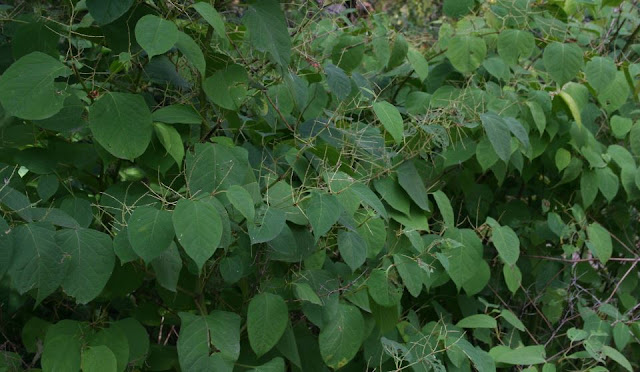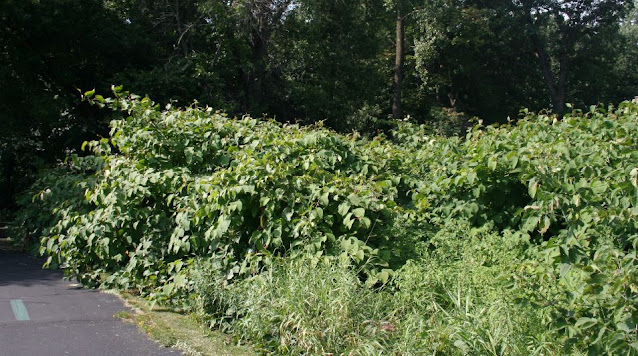Help is on the horizon to manage these aggressive plants.
Fallopia japonica (Houtt.) Ronse Decr., Japanese Knotweed
Fallopia sachalinensis (F.
Schmidt) Ronse Decr., Giant Knotweed
Fallopia x bohemica (Chrtek
& Chrtková) J.P. Bailey, Bohemian Knotweed
 |
| A stand of Japanese Knotweed in October. Although these plants are green, others are starting to yellow. The spiky growths are inflorescences that have shed their flowers and fruits. |
In Minnesota and around the world, invasive knotweeds are
some of the most difficult plants to manage.
Aided by vigorous rhizomes that can extend several meters
from a parent plant (1, 2), Japanese Knotweed, Giant Knotweed and their hybrid,
Bohemian Knotweed, can displace native plants, change soil chemistry, alter microbe
and invertebrate assemblages, and enhance soil erosion, especially on
riverbanks (3, 4, 5). In addition, they are potentially allelopathic, meaning
they can release compounds from living or decaying tissues that inhibit the
growth of some plants (6, 7).
Knotweeds are spreading in North America and elsewhere, and
as they do, so is the realization that controlling them is no easy task. (See EDDMapS for their distributions in
North America; use the genus Reynoutria, a synonym.) Although a variety
of chemical and mechanical control methods can be effective, all require years
of repeated efforts and monitoring for renewed growth (8). Mechanical methods –
digging and cutting – also demand meticulous attention, because fragments of rhizomes
or stems left behind can regenerate the plants (9).
 |
This large stand of Knotweed covers about 2,000 square feet along a property edge. The property is adjacent to a lake, offering the riparian habitat where knotweeds thrive and spread.
|
Biocontrol – the use of a plant’s natural enemies – now offers
some hope for an efficient alternative. Small, sap-sucking insects called Knotweed
Psyllids, Aphalara itadori, have been collected from Japan, part of
knotweeds’ native range. After years of study to determine that the insects
would effectively target only knotweeds, scientists released the psyllids into
several field locations in North America.
According to the North American Invasive Species Management
Association (NAISMA, 10), one race of the psyllids, called the Kyushu line, was
released on Japanese and Bohemian Knotweed populations in several states in
2020 and 2021. (Minnesota was not one of them.) Another race, called the
Hokkaido line, was released on Giant Knotweed populations in 2021. The nymphs
and adults feed on knotweed stems and leaves, removing sap from the plants and
causing the leaves to curl. The insects leave behind lerp, a flaky or stringy crystallized
form of honeydew, a sugary solution they excrete.
When winter arrives, the adult psyllids take shelter and
enter diapause, a time of suspended activity. Because the insects are native to
a similar climate in Japan, it is hoped the adults will survive winters here
and resume activity in spring, as they do in their original range. However,
according to NAISMA, no sustained populations have been confirmed. Additional
races or populations are being studied for future release.
Although psyllids are not yet a sure solution to knotweed
invasions, the research is promising. It also highlights the importance of
accurate plant identification, because different races of psyllids are
effective on different knotweeds. The Kyushu race is more effective on Japanese
and Bohemian Knotweed, whereas the Hokkaido race is better for Giant Knotweed.
A third race, called the Murakami line, is being studied for release on Bohemian
knotweed in Canada.
In Minnesota, Japanese, Giant and Bohemian Knotweed are on
the state Department of Agriculture’s noxious
weed list. They are classified as “prohibited-control,” meaning all
propagating parts, including seeds and vegetative parts, must be prevented from
spreading. In practice, that means treating
at least the above-ground growth before the stems flower in late summer, and if
the stems are cut, collecting and disposing of the cuttings so they don’t
escape and establish knotweed stands elsewhere.
In other words, it’s a lot of work, especially in large
patches. With some additional research and field tests, psyllids may someday make
that work easier.
Resources for Knotweed Identification and Management
Grevstad, F.S., J.E. Andreas, R.S.
Bourchier, and R. Shaw. 2022. Knotweeds (Fallopia spp.): History and
Ecology in North America. In: R.L. Winston, Ed. Biological Control of Weeds in
North America. North American Invasive Species Management Association,
Milwaukee, WI. NAISMA-BCW-2022-19-KNOTWEEDS-P. [Accessed online at 23198.pdf
(bugwoodcloud.org)]
Dusz M-A, Martin F-M, Dommanget F, Petit A,
Dechaume-Moncharmont C, Evette A. Review of Existing Knowledge and Practices of
Tarping for the Control of Invasive Knotweeds. Plants. 2021; 10(10):2152. https://doi.org/10.3390/plants10102152.
Minnesota Department of Natural
Resources. Non-native
knotweeds: Japanese, Bohemian, and Giant knotweed. Website accessed October
10, 2022.
Mary H. Meyer, University of
Minnesota Extension Service. Japanese
knotweed, a major noxious weed. October 6, 2020.
Angela Gupta, Amy Rager and Megan
M. Weber, University of Minnesota Extension Service. Japanese
knotweed. Reviewed in 2019.
Minnesota Department of
Agriculture. Knotweeds.
(Brochure.) No date.
Minnesota Department of
Agriculture. Japanese
Knotweed. Website accessed October 10, 2022.
Minnesota Department of
Transportation. Minnesota
Noxious Weeds. February 5, 2020.
Linda M. Wilson. British Columbia Ministry of Forests and Range.
Key to Identification of Invasive Knotweeds in British Columbia
References
1) Grevstad, F.S., J.E. Andreas, R.S.
Bourchier, and R. Shaw. 2022. Knotweeds (Fallopia spp.): History and
Ecology in North America. In: R.L. Winston, Ed. Biological Control of Weeds in
North America. North American Invasive Species Management Association,
Milwaukee, WI. NAISMA-BCW-2022-19-KNOTWEEDS-P. [Accessed online at 23198.pdf
(bugwoodcloud.org)]
2) Fennell M, Wade M, Bacon KL. 2018. Japanese
knotweed (Fallopia japonica): an analysis of capacity to cause
structural damage (compared to other plants) and typical rhizome
extension. PeerJ 6:e5246 https://doi.org/10.7717/peerj.5246
3) Lavoie, C. 2017. The impact of invasive knotweed species (Reynoutria
spp.) on the environment: review and research perspectives. Biological
Invasions 19: 2319-2337.
4) Matte, R., Boivin, M., and Lavoie, C. 2021. Japanese
knotweed increases soil erosion on riverbanks. River Research and Applications
38 (3): 561-572. DOI: 10.1002.rra.3918
5) Colleran, B., Lacy, S.N., and
Retamal, M.R. 2020. Invasive Japanese knotweed (Reynoutria japonica
Houtt.) and related knotweeds as catalysis for streambank erosion. River
Research and Applications 36 (9): 1962-1969. DOI: 10.1002/rra.3725.
6) Kato-Noguchi, H. Allelopathy of Knotweeds as Invasive Plants.
Plants 2022, 11, 3. DOI: 10.3390/plants11010003.
7) Drazan, D., Smith, A.G., Anderson, N.O., Becker, R., and Clark,
M. 2021. History of knotweed (Fallopia spp.) invasiveness. Weed
Science 69(6): 617-623. DOI: 10.1017/wsc.2021.62.
8) Grevstad, F.S., J.E. Andreas, R.S. Bourchier, R. Shaw, R.L.
Winston, and C.B. Randall. 2018. Biology and Biological Control of Knotweeds.
USDA Forest Service, Forest Health Assessment and Applied Sciences Team,
Morgantown, West Virginia. FHTET-2017-03. [Accessed online at https://bugwoodcloud.org/resource/pdf/Biology_&_Biological_Control_Series/FHTET-2017-03_Biological_Control_of_Knotweeds_508.pdf.]
9) Lawson JW, Fennell M, Smith MW, Bacon KL. 2021. Regeneration
and growth in crowns and rhizome fragments of Japanese knotweed (Reynoutria
japonica) and desiccation as a potential control strategy. PeerJ 9:e11783 https://doi.org/10.7717/peerj.11783
10) USDA. Field Release of the Knotweed Psyllid Aphalara itadori
(Hemiptera: Psyllidae) for Classical Biological Control of Japanese, Giant, and
Bohemian Knotweeds, Fallopia japonica, F. sachalinensis, and F. x bohemica
(Polygonaceae), in the Contiguous United States. Environmental Assessment,
January 2020.
11) Grevstad, F.S., J.E. Andreas, R.S.
Bourchier, and R. Shaw. 2022. Knotweeds (Fallopia spp.): History and
Ecology in North America. In: R.L. Winston, Ed. Biological Control of Weeds in
North America. North American Invasive Species Management Association,
Milwaukee, WI. NAISMA-BCW-2022-19-KNOTWEEDS-P. [Accessed online at 23198.pdf
(bugwoodcloud.org)]







